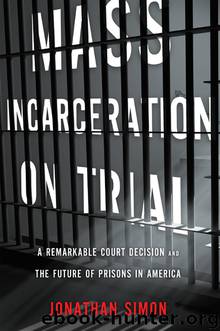Mass Incarceration on Trial by Jonathan Simon

Author:Jonathan Simon [Simon, Jonathan]
Language: eng
Format: epub
ISBN: 9781595587923
Publisher: New Press, The
5
Places of Extreme Peril
Coleman-Plata v. Schwarzenegger and California’s Prisons in the Era of Chronic Hyper-Overcrowding
Tough-on-crime politics have increased the population of California’s prisons dramatically while making necessary reforms impossible. As a result, the state’s prisons have become places “of extreme peril to the safety of persons” they house, while contributing little to the safety of California’s residents. . . .
—Coleman-Plata v. Schwarzenegger, Three-Judge Court, Final Order and Opinion, August 20091
Judge Henderson’s receivership order in the Plata case should have shaken the foundations of California’s political and legal establishment to its foundations. Instead, it marked the high tide of accountability on the part of the State. Having failed to acknowledge that anything was wrong despite the court ruling, California’s defendant officials made empty promises. In late 2006, a year after the receivership order in Plata placed prisoner medical treatment under direct court control and eleven years after the Coleman decision ordered reform of prison mental health care, lawyers for the prisoners in both cases returned to their respective courts and asked their judges to strengthen previous orders and impose a population cap as a way of relieving chronic extreme overcrowding. Without such reform, it was felt, the promise to repair an unconstitutionally defective medical care system for prisoners, unfilled for more than a decade, might never be kept. In August 2009, some months after the trial, the special three-judge court issued the largest prison injunction order in history. The opinion accompanying the order painted a radical portrait of mass incarceration at its most pathological.
Rarely if ever has a federal court so directly called into question a state’s penal policies. Even more remarkable, in an era of extreme deference by courts to state governments, especially on the topic of criminal justice, the court challenged the central rationale of four decades of mass incarceration in the United States. Instead of protecting the public by keeping dangerous men secure in humane conditions, the largest, most expensive prison system in the country had actually decreased public safety by keeping them in “extreme peril” under inhumane conditions.
The Coleman-Plata decision allows us to understand more clearly the last phase of mass incarceration in California, from the mid-1990s through 2009, a period distinguished by an unprecedented chronic hyper-overcrowding that ultimately led to a state of emergency. Although California’s overcrowding was uniquely bad, it’s an identifying symptom of mass incarceration throughout the country. The decision in Coleman-Plata points out a judicial path to ending it.
The Coleman-Plata decision considered mass incarceration in a different legal framework. In the Madrid, Coleman, and Plata cases, the legal question was whether or not California was violating the Eighth Amendment ban on cruel and unusual punishment. The population-cap remedy in Coleman-Plata was an answer to a different set of questions, not about the constitutional rights of prisoners but about overcrowding and public safety. The court was forced to ask these questions by the Prison Litigation Reform Act of 1996, passed at the height of mass incarceration with the support of both political parties and the enthusiastic signature of President Bill Clinton.
Download
This site does not store any files on its server. We only index and link to content provided by other sites. Please contact the content providers to delete copyright contents if any and email us, we'll remove relevant links or contents immediately.
Cecilia; Or, Memoirs of an Heiress — Volume 1 by Fanny Burney(32434)
Cecilia; Or, Memoirs of an Heiress — Volume 2 by Fanny Burney(31871)
Cecilia; Or, Memoirs of an Heiress — Volume 3 by Fanny Burney(31852)
The Great Music City by Andrea Baker(31348)
We're Going to Need More Wine by Gabrielle Union(18967)
All the Missing Girls by Megan Miranda(15568)
Pimp by Iceberg Slim(14393)
Bombshells: Glamour Girls of a Lifetime by Sullivan Steve(13972)
Talking to Strangers by Malcolm Gladwell(13222)
Norse Mythology by Gaiman Neil(13204)
Fifty Shades Freed by E L James(13157)
For the Love of Europe by Rick Steves(12977)
Mindhunter: Inside the FBI's Elite Serial Crime Unit by John E. Douglas & Mark Olshaker(9200)
Crazy Rich Asians by Kevin Kwan(9167)
The Lost Art of Listening by Michael P. Nichols(7406)
Enlightenment Now: The Case for Reason, Science, Humanism, and Progress by Steven Pinker(7228)
The Four Agreements by Don Miguel Ruiz(6630)
Bad Blood by John Carreyrou(6552)
Weapons of Math Destruction by Cathy O'Neil(6143)
